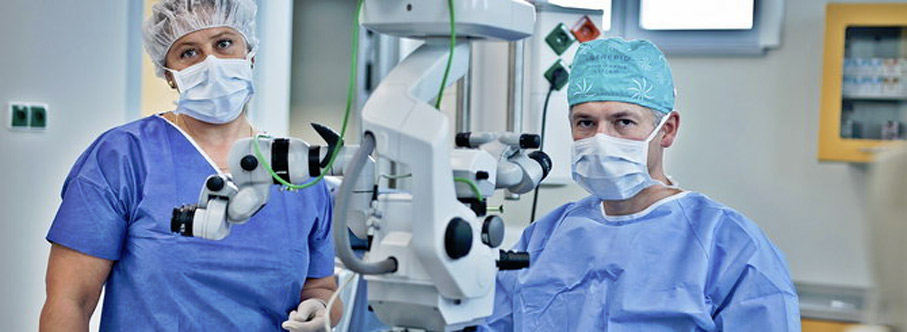Surgical procedures
DIVISION OF SURGERY OPHTHALMOLOGY, equipped with the state of the art equipment, air conditioned operating room, with digital recording of each surgery, allows to perform microsurgical ophthalmic procedures in a "one day surgery" mode.

See the world more clearly... Return to normal sight is easier than you think. Procedures of reducing the cataract by method of phacoemulsification are performed in the frames of „one day surgery” mode and usually the stay in the clinic takes up to several hours.
CATARACT
In SPEKTRUM we specialise in cataract surgeries. Every day we help people to appreciate clear vision again. Cataract is a disease of eye lens, based on its partial or complete eclipse. It makes the lens lose its most important feature, which is transparency.
The main and most common cause of cataract occurrence (accounting for as much as 99%) is the process of aging. Disease is proceeding slowly and painlessly through years. Cataract and sight disability, which occurs along with it, may be treated only surgically.
Proceeding opacification of the eye lens is usually discovered by optician during a routine control. Patient sees the symptoms only when bad vision (lack of focus, blurred view) makes it hard for him to perform everyday activities. Surgical cataract correction is a treatment, based on reduction of opaque lens and substituting it with artificial intraocular lens. The selection of injected lenses has a great influence on the quality of our vision, and what is connected with that, on comfort of living after cataract reduction surgery.
Types of lenses
Artificial lenses which substitute the natural lens are of different types. The classic division covers:
1) Single vision lenses – they allow to see sharply at only one distance (possibility of seeing only at far distance or reading at short distance). For other distances patient will need glasses.
2) Multifocal lenses – they allow to see sharply at all distances described by producer (e.g. good vision at far distances, intermediate distances, and reading) and they provide higher independence from glasses. Multifocal lenses use adaptation possibilities of our brain, on similar basis as progressive glasses.
3) Toric lenses – in cases of necessity to correct astigmatism. Surface of those lenses is professionally adjusted to patient’s eye, whose cornea with its shape is like spoon or elipsis. Astigmatism results in different refractives in certain meridians and it needs cylindrical correction. Toric lenses occur in a form of single vision lenses or multifocal lenses.
Are you a candidate for surgery?
Surgery of cataract removal should be performed in case, when the disease makes patient unable to conduct everyday activities. There is no age requirement for this surgery, it can be undertaken at every stage of life.
Proper treatment of cataract should be first consulted with an optician. On the basis of detailed sight test, doctor will make a decision, if the surgery should be undertaken or if he proposes an alternative way of treatment. Jointly with patient, the doctor makes a decision about the type of lens, which will be injected during the surgery of cataract removal. Surgery is painless, it takes about 20 minutes and it does not need longer hospitalization.
Benefits of surgery include:
- brighter, vivid colours
- sharper vision
- eliminating or minimizing the strength of glasses for long-sight distances
- better living comfort
Cataract and astigmatism
Nowadays the new revolutionary technology allows the surgeon to undertake one, ambulatory surgery during which clouded lens is replaced with artificial lens, designed also for astigmatism correction. All of this takes place during one surgery. By that, patient is able to minimize using glasses and contact lenses for long-sight distances.
Vitreous and retina surgeries (VITRECTOMY)
Whole spectre of surgical methods, vitrectomy. We treat vitreous body bleedings, epiretinal membranes, macular holes and other.
STRABISMUS SURGERIES
We deal with diagnosing and treating strabismus in chindren and adults. We are ready to conduct ophthalmological examinations for even the youngest patients. We also perform full range of surgeries in the scope of treating strabismus both in children and adults.
In OOK SPEKTRUM we are taking care of diagnostics and treatment of strabismus among children and adults. We are fully conscious how important is early diagnostics of various disorders of vision among children. We are prepared for ophtical tests, also among the youngest patients. We are also doing full variety of surgeries in cases of healing strabismus, among children and adults.
We see not only with an eye itself, but with the whole cerebral cortex, and that is why we should remember about physiological basis of creating vision expressions and vision in both strabismic eyes. Healing the strabismus relies on not only surgical cosmetic adjustment of eyes, but it should „teach” the whole cerebral cortex (vision) to work under new circumstances.
Strabismus is an asmetrical adjustment of eyeballs (convergent or disparate). This disease may show up during birth or in early childhood. Usually it is accompanied by various vision disorders (both one eyed, or both eyed). It is important that the treatment is undertaken as early as it is possible. In all cases of strabismus it is necessary to determine the sight defect (called refractive error).
Methods of treatment:
When it comes to children, strabismus is mostly healed with help of glasses, and in case of low vision – hiding the good eye. However, part of cases is impossible to heal completely – even though the vision is correct. Then, the surgery is necessary. It is recommended that the surgery is undertaken not after child is 10 years old. Because then there is a great chance not only for proper adjusting the eyeball, but also for correct vision in both eyes.
Surgical treatment of strabismus in adults is merely cosmetic, therefore, it may be performed in adults of all ages.
However, it is impossible to restore normal binocular vision.
The operations of strabismus are performed under full anaesthesia. They are usually performed as an out-patient service, i.e. the patient must arrive fasting, the surgery is performed and the patient may be discharged home after a few hours. The decision of discharge is made by the anaesthetist on the basis of clinical status. The operation itself lasts about half an hour.
We correct blepharoptosis of the upper eyelid as well as insufficiency of eyelid closure with the use of gold or platinum implants.
We perform surgeries of blepharoplasty which consist in removing excess of skin from the lower and/or upper eyelid.
Eyelid surgeries and other ophthalmic procedures
In Ophthalmology Clinical Centre SPEKTRUM eyelid surgeries and eye adnexa surgeries are performed by ophthalmologists with many years of experience.
We perform blepharoplasty surgery which consists in removing excess of skin from the lower and/or upper eyelid. Sagging eyelid skin causes restricted field of vision, which is not only an aesthetic problem but also a health problem. It may cause fatigue and eye pain. It applies to people of all ages.
We also treat incorrect eyelid positions: ectropion- a condition in which the edge of the eyelid does not adjoin the eyeball but lags behind it, or entropion- a condition in which eyelashes roll inwards causing irritation and damage to the surface of the eye.
We also carry out procedures on eye conjunctival. The most common procedure is the removal of pterygium, which extends onto the transparent cornea, often causing astigmatism.
We remove lesions in the eyelids: Meibomian cysts, papillae, cysts, cutaneous horns, sebaceous cysts, xanthelasmata, naevi, which are subsequently examined histopathologically.
We perform laser eyelash hair removal. The procedure involves the removal of abnormally growing eyelashes from the root. These are usually the eyelashes touching the eyeball, thereby irritating it.
We perform procedural treatment of dry eye syndrome by sealing lacrimal point with plug.
In case of severe dry eye syndrome, usually when all other treatment options have been tried, electrocoagulation of lacrimal point may be performed. This treatment permanently seals lacrimal point increasing the amount of tears in conjunctival sac.



